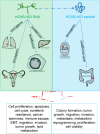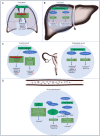A concise review of the regulatory, diagnostic, and prognostic implications of HOXB-AS3 in tumors
- PMID: 38213732
- PMCID: PMC10777036
- DOI: 10.7150/jca.91033
A concise review of the regulatory, diagnostic, and prognostic implications of HOXB-AS3 in tumors
Abstract
Recent studies have reported that HOXB-AS3 (HOXB Cluster Antisense RNA 3) is an intriguing molecule with dual functionality as a long noncoding RNA (lncRNA) and putative coding peptide in tumorigenesis and progression. The significant expression alterations of HOXB-AS3 were detected in diverse cancer types and closely correlated with clinical stage and patient survival. Furthermore, HOXB-AS3 was involved in a spectrum of biological processes in solid tumors and hematological malignancies, such as stemness, lipid metabolism, migration, invasion, and tumor growth. This review comprehensively analyzes its clinical relevance for diagnosis and prognosis across human tumors and summarizes its functional role and regulatory mechanisms in different malignant tumors, including liver cancer, acute myeloid leukemia, ovarian cancer, lung cancer, endometrial carcinoma, colon cancer, and oral squamous cell carcinoma. Overall, HOXB-AS3 emerges as a promising biomarker and novel therapeutic target in multiple human tumors.
Keywords: HOXB-AS3; biological functions; clinical significance; human tumors; molecular target; regulatory mechanisms.
© The author(s).
Conflict of interest statement
Competing Interests: The authors have declared that no competing interest exists.
Figures








Similar articles
-
Long non-coding RNA (lncRNA) HOXB-AS3 promotes cell proliferation and inhibits apoptosis by regulating ADAM9 expression through targeting miR-498-5p in endometrial carcinoma.J Int Med Res. 2021 Jun;49(6):3000605211013548. doi: 10.1177/03000605211013548. J Int Med Res. 2021. PMID: 34187214 Free PMC article.
-
Long non-coding RNA HOXB-AS3 promotes myeloid cell proliferation and its higher expression is an adverse prognostic marker in patients with acute myeloid leukemia and myelodysplastic syndrome.BMC Cancer. 2019 Jun 24;19(1):617. doi: 10.1186/s12885-019-5822-y. BMC Cancer. 2019. PMID: 31234830 Free PMC article.
-
Overexpression of long noncoding RNA HOXB-AS3 indicates an unfavorable prognosis and promotes tumorigenesis in epithelial ovarian cancer via Wnt/β-catenin signaling pathway.Biosci Rep. 2019 Aug 2;39(8):BSR20190906. doi: 10.1042/BSR20190906. Print 2019 Aug 30. Biosci Rep. 2019. PMID: 31337688 Free PMC article.
-
HOXC Cluster Antisense RNA 3, a Novel Long Non-Coding RNA as an Oncological Biomarker and Therapeutic Target in Human Malignancies.Onco Targets Ther. 2023 Oct 24;16:849-865. doi: 10.2147/OTT.S425523. eCollection 2023. Onco Targets Ther. 2023. PMID: 37899986 Free PMC article. Review.
-
The integrated comprehension of lncRNA HOXA-AS3 implication on human diseases.Clin Transl Oncol. 2022 Dec;24(12):2342-2350. doi: 10.1007/s12094-022-02920-w. Epub 2022 Aug 20. Clin Transl Oncol. 2022. PMID: 35986859 Free PMC article. Review.
Cited by
-
A Peptide Encoded by lncRNA HOXB-AS3 Promotes Cigarette Smoke-Induced Inflammation in Bronchial Epithelial Cells via EZH2-Mediated H3K27me3 Modification.Int J Chron Obstruct Pulmon Dis. 2025 May 20;20:1543-1553. doi: 10.2147/COPD.S495581. eCollection 2025. Int J Chron Obstruct Pulmon Dis. 2025. PMID: 40417409 Free PMC article.
References
-
- Chhikara BS, Parang K. Global Cancer Statistics 2022: the trends projection analysis. Chemical Biology Letters. 2023;10:451.
-
- Sung H, Ferlay J, Siegel RL, Laversanne M, Soerjomataram I, Jemal A. et al. Global Cancer Statistics 2020: GLOBOCAN Estimates of Incidence and Mortality Worldwide for 36 Cancers in 185 Countries. CA: a cancer journal for clinicians. 2021;71:209–49. - PubMed
-
- Siegel RL, Miller KD, Fuchs HE, Jemal A. Cancer statistics, 2022. CA: a cancer journal for clinicians. 2022;72:7–33. - PubMed
Publication types
LinkOut - more resources
Full Text Sources

